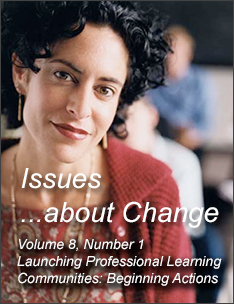Conclusion and References
This paper has identified themes that describe actions taken at schools to develop professional learning communities. It was clear that for the majority of the Co-Developers, the first half-year of work with the schools has been devoted not to implementing change but to becoming acquainted with the school staff and understanding their present way of operating. Co-Developers identified special strengths of individuals who had the potential to play important roles in helping a school become a professional learning community. They were particularly cognizant of the principal's leadership qualities and the extent to which leadership was shared among others in the school.
In addition, Co-Developers were gaining a sense of the resources currently available to the school and the degree to which teachers were committed to learning more about their practice. They were also trying to develop positive relationships with the principals with whom they had formed a partnership and with the school staff as a whole. Since all of these strategies produce little in the way of actions on the part of the Co-Developers in their role as facilitators of change, their reports of what they did are notably slim. The reports of Co-Developer principals were richer in description of actions, it is assumed, because they were already familiar with their schools and committed to the dimensions of a PLC.
Within the stories, however, several actions taken by the Co-Developers seemed particularly compelling. First, Co-Developers who were at the campus frequently and personally involved from the very beginning in something that the school was doing or wanted to do, as opposed to taking a spectator role, seemed to be more actively engaged, doing more. For example, one Co-Developer invited faculty to participate in a team-building activity at her residence at the beginning of the school year. Her planning and involvement in these activities helped her to be accepted as a facilitator for the school's desired goals. Another Co-Developer assisted the principal and the lead teacher in preparing their presentation about professional learning communities for the school board. Her contribution in developing and presenting the visual materials and in presenting the project to the school staff modeled shared and supportive leadership and was appreciated by the principal. These actions helped characterize the Co-Developer in the eyes of the administration and staff as an advocate and a resource for the school.
Second, some Co-Developers developed strategies that enabled school staffs to plan together or to talk with one another about their work. Working directly with teachers rather than only with or through the administration seems to communicate that the Co-Developer is willing to get at the "heart" of school change. In some cases, Co-Developers offered processes to bring teachers together to discuss issues of concern at their campuses. In other cases, Co-Developers agreed to study and learn about new practices alongside teachers. This suggests that creating a professional learning community requires change facilitators "to get down in the trenches" with teachers and to struggle with them in whatever they are trying to do differently.
Third, knowing how to bring a school's existing disjointed and poorly articulated efforts into alignment (wherever possible) was an important contribution that some Co-Developers made, especially at the beginning of the improvement process. Co-Developers who served in this "sense-making" role helped to clarify ways in which the staff's actions supported values to which they were committed. This role also helped the principal and staff to maintain their focus upon what they believed to be important, to identify resources that could help them achieve their goals, and to reduce distractions that would get them off course. In these ways Co-Developers supported the staff's evolving and continuing commitment to the change effort they were developing.
This analysis of Co-Developers' initial actions and interactions with their schools offers insight into beginning steps that others can take to help schools become PLCs. Although each school context is unique, with different resources and needs, and requires different approaches from those who facilitate change, it is apparent that some strategies seem to be particularly compelling in influencing change. Ongoing study of Co-Developer actions at sites participating in the CCCII project at SEDL will provide further information about how to create schools as professional learning communities.
References
- Hord, S. M. (1997). Professional learning communities: What are they and why are they important? Issues. . . about Change, 6(1), 1-8.
- Newman, Fred M. (1999). What is a "restructured" school? A framework to clarify means and ends. Issues in Restructuring Schools., no. 1 (Fall 1991). Wisconsin Center for Education Research: Madison, Wisconsin.
- Sergiovanni, T. J. (1994). Building Community in Schools. San Francisco: Jossey-Bass.
- Weisbord, M. R., & Janoff, S. (1995). Future Search: An Action Guide to Finding Common Ground in Organizations and Communities. San Francisco: Berrett-Koehler.
Next Page: Credits and Disclaimers

